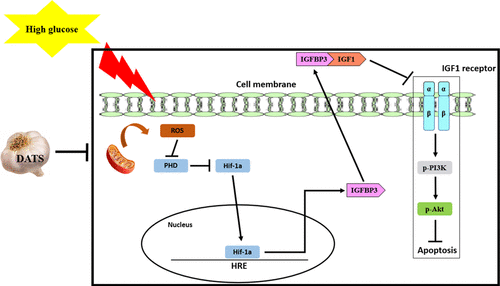当前位置:
X-MOL 学术
›
J. Agric. Food Chem.
›
论文详情
Our official English website, www.x-mol.net, welcomes your feedback! (Note: you will need to create a separate account there.)
Diallyl Trisulfide Suppresses High-Glucose-Induced Cardiomyocyte Apoptosis by Targeting Reactive Oxygen Species-Mediated Hypoxia-Inducible Factor-1α/Insulin-like Growth Factor Binding Protein 3 Activation
Journal of Agricultural and Food Chemistry ( IF 6.1 ) Pub Date : 2021-09-24 , DOI: 10.1021/acs.jafc.1c02384 Kuan-Ho Lin, Yu-Min Wei, Chung-Hung Liu, Jian-Sheng Liu, I-Chieh Huang, Vijaya Padma Viswanadha, Chih-Yang Huang, Wei-Wen Kuo
Journal of Agricultural and Food Chemistry ( IF 6.1 ) Pub Date : 2021-09-24 , DOI: 10.1021/acs.jafc.1c02384 Kuan-Ho Lin, Yu-Min Wei, Chung-Hung Liu, Jian-Sheng Liu, I-Chieh Huang, Vijaya Padma Viswanadha, Chih-Yang Huang, Wei-Wen Kuo

|
It has been reported that 80% of diabetic patients die due to cardiovascular diseases. We previously demonstrated that activated hypoxia-inducible factor-1α (HIF-1 α)/insulin-like growth factor binding protein-3 (IGFBP-3) signaling by reactive oxygen species (ROS)-regulated prolyl hydroxylase domain-containing protein (PHD) is involved in high-glucose (HG)-induced cardiac apoptosis. Diallyl trisulfide (DATS), a garlic component, shows the strongest inhibitory effect on diabetic cardiomyopathy. In this study, we investigated whether HIF-1α/IGFBP-3 signaling governs the antiapoptotic effect by DATS on HG-exposed cardiomyocytes. It was observed that significantly increased levels of cell apoptosis and decreased Akt phosphorylation were reversed by DATS in HG-exposed cardiac cells. H2O2 and PHD small interfering RNA treatments increased HIF-1α and IGFBP-3 protein levels, which were decreased by DATS treatment. Overexpression of HIF-1α and IGFBP-3 increased HG-induced cell apoptosis, which was suppressed by DATS. The coimmunoprecipitation assay results showed that DATS not only increased the IGF-1 level and reduced IGFBP-3 level but also suppressed their extracellular association for cardiac cells exposed to HG. Experiments using neonatal cardiomyocytes and hearts showed similar results. These findings indicate that the effect of ROS-regulated PHD on the activation of HIF-1α/IGFBP-3 signaling governs the antiapoptotic effect by DATS on HG-exposed cardiomyocytes.
中文翻译:

二烯丙基三硫化物通过靶向活性氧介导的缺氧诱导因子-1α/胰岛素样生长因子结合蛋白 3 激活抑制高糖诱导的心肌细胞凋亡
据报道,80%的糖尿病患者死于心血管疾病。我们之前证明了活性氧 (ROS) 调节的含脯氨酰羟化酶结构域蛋白 (PHD) 激活的缺氧诱导因子-1α (HIF-1α)/胰岛素样生长因子结合蛋白-3 (IGFBP-3) 信号传导) 参与高葡萄糖 (HG) 诱导的心脏细胞凋亡。二烯丙基三硫化物(DATS)是大蒜的一种成分,对糖尿病心肌病的抑制作用最强。在这项研究中,我们研究了 HIF-1α/IGFBP-3 信号是否控制 DATS 对暴露于 HG 的心肌细胞的抗凋亡作用。据观察,在暴露于 HG 的心脏细胞中,DATS 逆转了显着增加的细胞凋亡水平和降低的 Akt 磷酸化。H 2 O 2和 PHD 小干扰 RNA 处理增加了 HIF-1α 和 IGFBP-3 蛋白水平,DATS 处理降低了这些水平。HIF-1α 和 IGFBP-3 的过表达增加了 HG 诱导的细胞凋亡,这被 DATS 抑制。共免疫沉淀试验结果表明,DATS 不仅增加 IGF-1 水平并降低 IGFBP-3 水平,而且还抑制了它们与暴露于 HG 的心脏细胞的细胞外结合。使用新生儿心肌细胞和心脏的实验显示了类似的结果。这些发现表明 ROS 调节的 PHD 对 HIF-1α/IGFBP-3 信号激活的影响控制着 DATS 对 HG 暴露的心肌细胞的抗凋亡作用。
更新日期:2021-10-06
中文翻译:

二烯丙基三硫化物通过靶向活性氧介导的缺氧诱导因子-1α/胰岛素样生长因子结合蛋白 3 激活抑制高糖诱导的心肌细胞凋亡
据报道,80%的糖尿病患者死于心血管疾病。我们之前证明了活性氧 (ROS) 调节的含脯氨酰羟化酶结构域蛋白 (PHD) 激活的缺氧诱导因子-1α (HIF-1α)/胰岛素样生长因子结合蛋白-3 (IGFBP-3) 信号传导) 参与高葡萄糖 (HG) 诱导的心脏细胞凋亡。二烯丙基三硫化物(DATS)是大蒜的一种成分,对糖尿病心肌病的抑制作用最强。在这项研究中,我们研究了 HIF-1α/IGFBP-3 信号是否控制 DATS 对暴露于 HG 的心肌细胞的抗凋亡作用。据观察,在暴露于 HG 的心脏细胞中,DATS 逆转了显着增加的细胞凋亡水平和降低的 Akt 磷酸化。H 2 O 2和 PHD 小干扰 RNA 处理增加了 HIF-1α 和 IGFBP-3 蛋白水平,DATS 处理降低了这些水平。HIF-1α 和 IGFBP-3 的过表达增加了 HG 诱导的细胞凋亡,这被 DATS 抑制。共免疫沉淀试验结果表明,DATS 不仅增加 IGF-1 水平并降低 IGFBP-3 水平,而且还抑制了它们与暴露于 HG 的心脏细胞的细胞外结合。使用新生儿心肌细胞和心脏的实验显示了类似的结果。这些发现表明 ROS 调节的 PHD 对 HIF-1α/IGFBP-3 信号激活的影响控制着 DATS 对 HG 暴露的心肌细胞的抗凋亡作用。


























 京公网安备 11010802027423号
京公网安备 11010802027423号